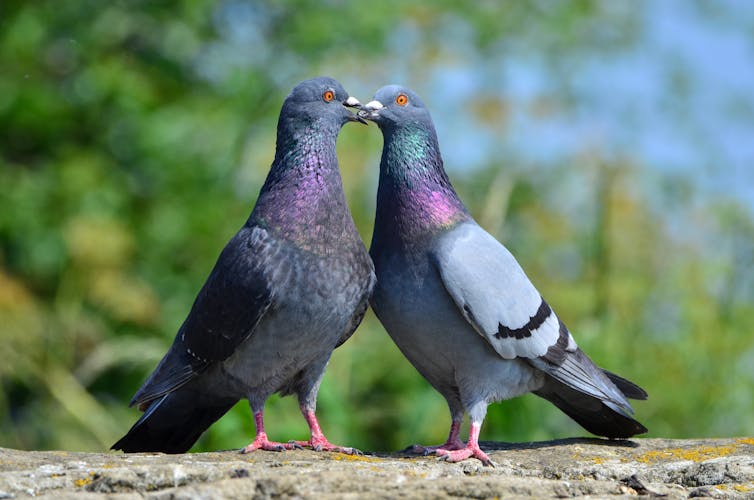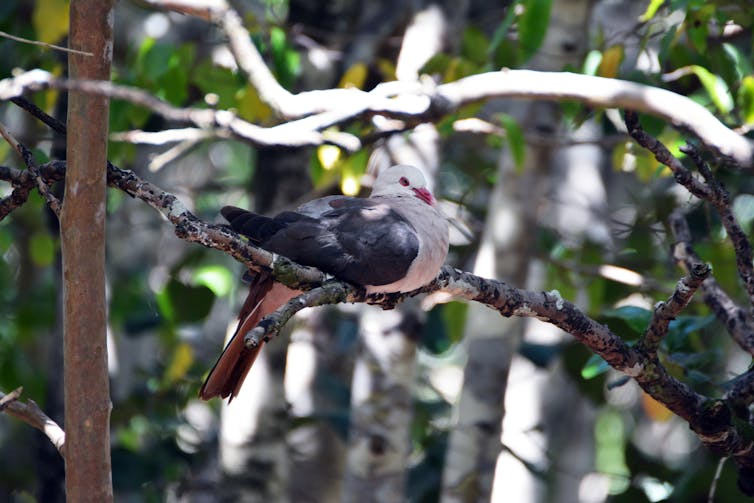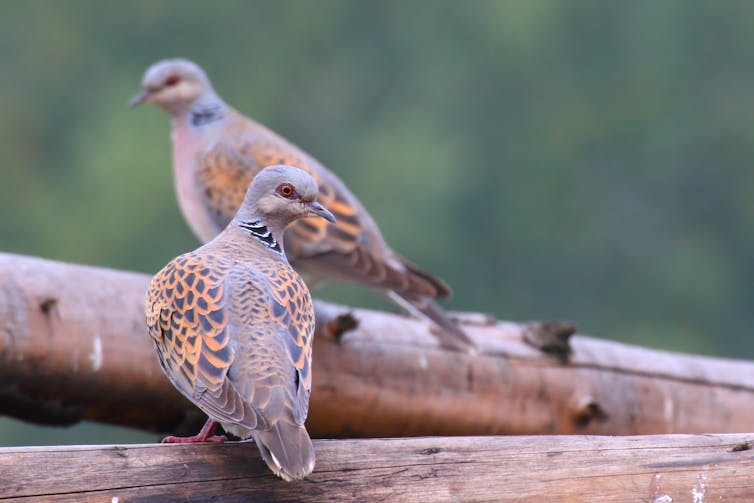We understandably focus so much effort on rare species while we don’t notice that the commonplace is in sharp decline.

A pink pigeon in the wild of Mauritius. Arcalexx/Flickr, CC BY-SA
There is a touch of the Dickensian about the urban pigeon, often seen hobbling about on gnarled stumps, pecking at trash. The mongrel mix of grey and brown plumage on feral pigeons adds to the dowdy look, the occasional iridescent flash on neck feathers too obvious, too cheap. Dickens himself wrote of the pigeons of Spitalfields in London, associated with the poorest hovels:
The pigeon hutches and pigeon traps on the tops of poor dwelling.
Our local shopping mall entrance regularly echoes to the wheeling scream of a recorded peregrine falcon, played purposefully to scare away the pigeons. Urban animal life, whether domestic or feral, has often been lumped in with the socially excluded – beggars, drunks and revellers and the like.

The prettier pink cousin
Meanwhile other pigeons provoke intense concern. The pink pigeon of Mauritius is a heartwarming example of what we can do to protect endangered species. In 1975 only ten birds lingered at just one site. It was listed by the IUCN as Critically Endangered in 1994 – “possibly the most threatened bird in the world”. Today there are around 400 in the wild of Mauritius.
This pigeon has some distinct advantages. It is pink, it lives on an exotic island famous for the Dodo and it has had some big-name backers – notably author Gerald Durrell, who brought some into captivity in 1976 to breed and started a programme of releasing them back into the wild – along with intensive habitat management.
As a result, the pink pigeon’s numbers and range have markedly increased, with wild-bred young now turning up. Pink pigeons in Mauritius have turned the corner. Meanwhile their urban grey brethren remain every bit the unloved city mob.

The beak shall inherit the Earth
The urban pigeon is a great example of the inheritors of the Earth described by ecologist Chris Thomas – species that do well because of us, thriving in the world we have created. Theirs is a biodiversity of cityscapes, a zoopolis deserving of our respect. Not least because the rats, racoons and pigeons of our cities are so like us – at home in concrete landscapes and on diets of processed food.
I am not against the effort expended on the pink pigeon at all. They are cute and exotic, two prime criteria for conservation – but the urban pigeon deserves our respect too. The great shame is that other members of the pigeon family are also at risk, species that were once commonplace, which can hardly be said of the pink pigeon.
Take the turtle dove, for example, which belongs to the same family as pigeons. In the UK, the turtle dove population has declined by more than 95% in barely two decades. This once common farmland dove is a bird of high summer – its call is a sleepy drone on the hottest days. It is the dove of poetry and ballads, the Phoenix’s lover in a Shakespeare sonnet.
We understandably focus so much effort on rare species while we don’t notice that the commonplace is in sharp decline. Thankfully, the turtle dove is now the focus of its own conservation projects.
From charming Darwin to fine pets
The urban pigeon needs no such help, although they have fallen from grace since the days when pigeon fancying was a widespread hobby, which even had Charles Darwin hooked. Pigeons in all their domestic variety feature large in Darwin’s book, The Variation of Animals and Plants Under Domestication.
Darwin installed a pigeon breeding loft in his home and gathered invaluable insights into how traits are inherited through reproduction by studying their breeding. Pigeons are likely to be more qualified muses for Darwin’s theories on evolution by natural selection than the commonly cited Galapagos Island finches.
The story lends a distinct air of erudite science and respectability to the gentlemen pigeon fanciers of Victorian times. Not so any more – pigeon fancying is now a peripheral pastime of a lost world of old men tending their pigeon crees in tucked away allotments and backyards.
Turtle doves and pink pigeons will always arouse our sympathy, while the dodo and passenger pigeon – once the most numerous bird in North America before dying out in 1914 – stand as accusing witnesses. Meanwhile, the feral pigeon battles on, hobbling, chased by kids, tormented by mall managers, swallowed whole by pelicans. You can’t help but admire them.
Mike Jeffries, Associate Professor, Ecology, Northumbria University, Newcastle
This article is republished from The Conversation under a Creative Commons license. Read the original article.






